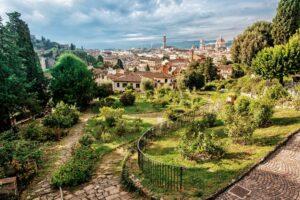Fodor's Expert Review Santa Maria del Carmine
Fire destroyed most of this church in the 18th century, but, miraculously, the Cappella Brancacci—at the end of the right transept and containing a masterpiece of Renaissance painting—survived almost intact. The fresco cycle here changed the course of Western art and is the work of three artists: Masaccio and Masolino (1383–circa 1447), who began it around 1424, and Filippino Lippi, who finished it some 50 years later, after a long interruption when the sponsoring Brancacci family was exiled. It was, however, Masaccio's work that opened a new frontier for painting, as he was among the first artists to employ single-point perspective; tragically, he died in 1428 at the age of 27, so he didn't live to experience the revolution his innovations caused.
Masaccio collaborated with Masolino on several of the frescoes, but his style predominates in the Tribute Money, on the upper-left wall; St. Peter Baptizing, on the upper altar wall; the Distribution of Goods,... READ MORE
Fire destroyed most of this church in the 18th century, but, miraculously, the Cappella Brancacci—at the end of the right transept and containing a masterpiece of Renaissance painting—survived almost intact. The fresco cycle here changed the course of Western art and is the work of three artists: Masaccio and Masolino (1383–circa 1447), who began it around 1424, and Filippino Lippi, who finished it some 50 years later, after a long interruption when the sponsoring Brancacci family was exiled. It was, however, Masaccio's work that opened a new frontier for painting, as he was among the first artists to employ single-point perspective; tragically, he died in 1428 at the age of 27, so he didn't live to experience the revolution his innovations caused.
Masaccio collaborated with Masolino on several of the frescoes, but his style predominates in the Tribute Money, on the upper-left wall; St. Peter Baptizing, on the upper altar wall; the Distribution of Goods, on the lower altar wall; and the Expulsion of Adam and Eve, on the chapel's upper-left entrance pier. If you compare the last painting with some of the chapel's other works, you'll see a pronounced difference.
The figures of Adam and Eve possess a startling presence thanks to the dramatic way in which their bodies seem to reflect light. Masaccio shaded his figures consistently, so as to suggest a single, strong source of light within the world of the painting but outside its frame. In so doing, he imitated with paint the real-world effect of light on mass, giving his figures a sculptural reality unprecedented in his day. But his skill went beyond mere technical innovation. In the faces of Adam and Eve, you see more than finely modeled figures; you see terrible shame and suffering depicted with a humanity rarely achieved in art.
READ LESS







